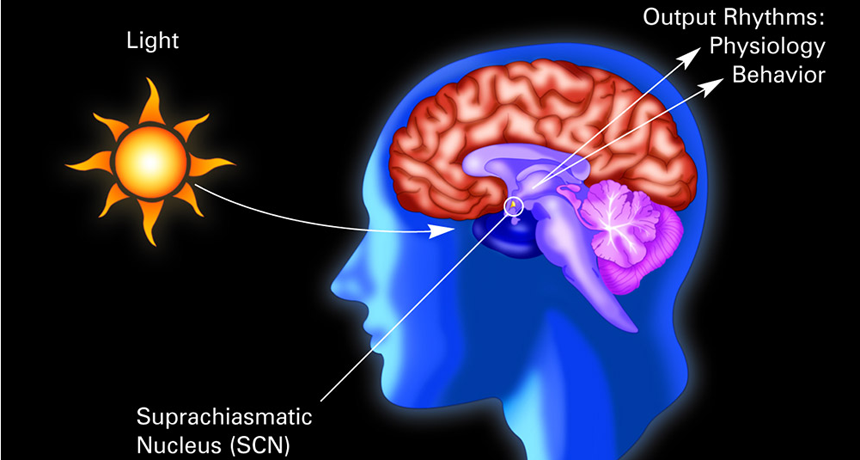Explainer: Our bodies’ internal clocks
Biological clocks determine hunger, sleepiness and other daily rhythms

This illustration shows how light that enters the eyes can send a signal to make sure the body’s master clock is reset daily. This ensures the internal pacemaker is always working in sync with the local time.
Nat.l Inst. of Gen’l Medical Sciences
Share this:
- Share via email (Opens in new window) Email
- Click to share on Facebook (Opens in new window) Facebook
- Click to share on X (Opens in new window) X
- Click to share on Pinterest (Opens in new window) Pinterest
- Click to share on Reddit (Opens in new window) Reddit
- Share to Google Classroom (Opens in new window) Google Classroom
- Click to print (Opens in new window) Print
People are precisely tuned to eat, sleep and wake at specific times. These predictable patterns are known as circadian rhythms. (In Latin, circa means “around,” and dian relates to “day.”) As their name would suggest, circadian rhythms are cycles that occur about once every 24 hours. They are driven largely by an internal “clock.” But outside factors can influence the cycles too. Among such factors: diet, stress and exposure to light.
Every living thing possesses an internal master clock. In people, it resides in the middle of the brain. It is called the suprachiasmatic nucleus (SU-prah-ky-as-mat-ik NU-klee-us). But don’t let the clock’s oversize name fool you. This timepiece is only about as big as a grain of rice. Still, it coordinates all of the body’s daily cycles — from sleeping and waking to hunger and hormone production.
On its own, the body clock doesn’t keep very good time. In some people and other life forms this clock may run a little fast. In others a bit slow. That’s why this pacemaker must be regularly reset. In people and many living things, the sun does this.
The circadian system “is probably one of the most ancient biological systems you can imagine,” says Paolo Sassone-Corsi. He’s a molecular biologist who works at the University of California, Irvine. In fact, he says, this clock has probably been at play as long as there has been life on Earth.
Circadian rhythms are linked to the chemical reactions that maintain life in every cell. Together, these reactions are known as the body’s metabolism. Those reactions vary a lot over the course of a day. But their schedule on any day will differ little from that of another day. This shows, he says, that “basically every single step of our everyday life is controlled by the clock.”
Light cues reach the body’s master clock through very specialized cells in the retina of the eye. This light-sensitive layer of tissue lines the back of our eyes. When light hits its cells, they dispatch chemicals to the brain’s master clock. There, they trigger about 20,000 neurons, a type of cell which “talks” to the rest of the body.
Those neurons tell the body when to release hormones, for instance. Hormones relay chemical instructions to distant parts of the body. These chemical messengers turn on activities at precise times and in specific cells. They say, for example: It’s time to eat. Or it’s time to wake up. Or it’s time to be really alert. But the clock — and the cycles it regulates — can become confused when people travel across many time zones, triggering jet lag.
Scientists once thought that the brain’s central clock was the body’s only one — that it alone directed every tissue in the body. But in the past 15 years, researchers have found the real story is more complex.
“We’re finding that each little cell [in the body] has its own clock,” explains Sarah Forbes-Robertson. She’s a sport scientist at Swansea University in Wales. But scientists do not yet have a complete picture of all those clocks. They’re also still trying to learn how they all work together.






